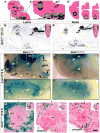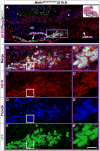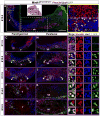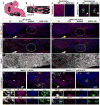Math1 is essential for the development of hindbrain neurons critical for perinatal breathing
- PMID: 19914183
- PMCID: PMC2818435
- DOI: 10.1016/j.neuron.2009.10.023
Math1 is essential for the development of hindbrain neurons critical for perinatal breathing
Abstract
Mice lacking the proneural transcription factor Math1 (Atoh1) lack multiple neurons of the proprioceptive and arousal systems and die shortly after birth from an apparent inability to initiate respiration. We sought to determine whether Math1 was necessary for the development of hindbrain nuclei involved in respiratory rhythm generation, such as the parafacial respiratory group/retrotrapezoid nucleus (pFRG/RTN), defects in which are associated with congenital central hypoventilation syndrome (CCHS). We generated a Math1-GFP fusion allele to trace the development of Math1-expressing pFRG/RTN and paratrigeminal neurons and found that loss of Math1 did indeed disrupt their migration and differentiation. We also identified Math1-dependent neurons and their projections near the pre-Bötzinger complex, a structure critical for respiratory rhythmogenesis, and found that glutamatergic modulation reestablished a rhythm in the absence of Math1. This study identifies Math1-dependent neurons that are critical for perinatal breathing that may link proprioception and arousal with respiration.
Figures








Comment in
-
Math1: waiting to inhale.Neuron. 2009 Nov 12;64(3):293-5. doi: 10.1016/j.neuron.2009.10.025. Neuron. 2009. PMID: 19914175
Similar articles
-
Excitatory neurons of the proprioceptive, interoceptive, and arousal hindbrain networks share a developmental requirement for Math1.Proc Natl Acad Sci U S A. 2009 Dec 29;106(52):22462-7. doi: 10.1073/pnas.0911579106. Epub 2009 Dec 18. Proc Natl Acad Sci U S A. 2009. PMID: 20080794 Free PMC article.
-
Math1: waiting to inhale.Neuron. 2009 Nov 12;64(3):293-5. doi: 10.1016/j.neuron.2009.10.025. Neuron. 2009. PMID: 19914175
-
Phox2b, RTN/pFRG neurons and respiratory rhythmogenesis.Respir Physiol Neurobiol. 2009 Aug 31;168(1-2):13-8. doi: 10.1016/j.resp.2009.03.007. Epub 2009 Mar 28. Respir Physiol Neurobiol. 2009. PMID: 19712902 Review.
-
Understanding the rhythm of breathing: so near, yet so far.Annu Rev Physiol. 2013;75:423-52. doi: 10.1146/annurev-physiol-040510-130049. Epub 2012 Oct 29. Annu Rev Physiol. 2013. PMID: 23121137 Free PMC article. Review.
-
Math1 expression redefines the rhombic lip derivatives and reveals novel lineages within the brainstem and cerebellum.Neuron. 2005 Oct 6;48(1):31-43. doi: 10.1016/j.neuron.2005.08.024. Neuron. 2005. PMID: 16202707
Cited by
-
Axonal Projection Patterns of the Dorsal Interneuron Populations in the Embryonic Hindbrain.Front Neuroanat. 2021 Dec 24;15:793161. doi: 10.3389/fnana.2021.793161. eCollection 2021. Front Neuroanat. 2021. PMID: 35002640 Free PMC article. Review.
-
POU4F3 pioneer activity enables ATOH1 to drive diverse mechanoreceptor differentiation through a feed-forward epigenetic mechanism.Proc Natl Acad Sci U S A. 2021 Jul 20;118(29):e2105137118. doi: 10.1073/pnas.2105137118. Proc Natl Acad Sci U S A. 2021. PMID: 34266958 Free PMC article.
-
Conditional deletion of Atoh1 using Pax2-Cre results in viable mice without differentiated cochlear hair cells that have lost most of the organ of Corti.Hear Res. 2011 May;275(1-2):66-80. doi: 10.1016/j.heares.2010.12.002. Epub 2010 Dec 10. Hear Res. 2011. PMID: 21146598 Free PMC article.
-
Brainstem respiratory oscillators develop independently of neuronal migration defects in the Wnt/PCP mouse mutant looptail.PLoS One. 2012;7(2):e31140. doi: 10.1371/journal.pone.0031140. Epub 2012 Feb 17. PLoS One. 2012. PMID: 22363567 Free PMC article.
-
LIN-32/Atonal Controls Oxygen Sensing Neuron Development in Caenorhabditis elegans.Sci Rep. 2017 Aug 4;7(1):7294. doi: 10.1038/s41598-017-07876-4. Sci Rep. 2017. PMID: 28779171 Free PMC article.
References
-
- Amiel J, Laudier B, Attie-Bitach T, Trang H, de Pontual L, Gener B, Trochet D, Etchevers H, Ray P, Simonneau M, et al. Polyalanine expansion and frameshift mutations of the paired-like homeobox gene PHOX2B in congenital central hypoventilation syndrome. Nat Genet. 2003;33:459–461. - PubMed
-
- Ben-Arie N, Bellen HJ, Armstrong DL, McCall AE, Gordadze PR, Guo Q, Matzuk MM, Zoghbi HY. Math1 is essential for genesis of cerebellar granule neurons. Nature. 1997;390:169–172. - PubMed
-
- Ben-Arie N, Hassan BA, Bermingham NA, Malicki DM, Armstrong D, Matzuk M, Bellen HJ, Zoghbi HY. Functional conservation of atonal and Math1 in the CNS and PNS. Development. 2000;127:1039–1048. - PubMed
Publication types
MeSH terms
Substances
Grants and funding
LinkOut - more resources
Full Text Sources
Other Literature Sources
Molecular Biology Databases
Research Materials

